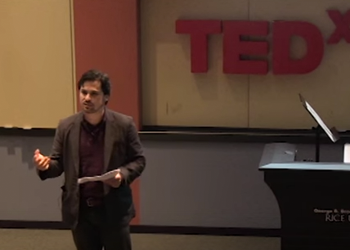Hearing loss: How modern treatments, technology can help
Approximately 48 million people in the United States suffer from hearing loss. However, Dr. Alex Sweeney, director of the Center for Hearing and Balance at Baylor College of Medicine, says modern treatments and improvements to hearing devices have made hearing loss a manageable issue in many cases.
Types of hearing loss
Sweeney says the two major types of hearing loss are conductive and sensorineural.

“Conductive hearing loss occurs when sound waves dissipate while traveling through the outer ear, eardrum, or middle ear. It can be caused by ear infections, ear tumors, or holes in the ear drum. Many patients experience this form of hearing loss,” he said.
Damage to nerve pathways from the inner ear to the brain can result in sensorineural hearing loss. It is a common type of hearing loss in the United States and is often caused by aging or frequent exposure to loud sounds.
“With sensorineural hearing loss, the signal entering the inner ear may be strong, but if it weakens while being converted to a signal your brain understands, you will have a hearing loss. In other words, sound that is generally loud enough to be heard becomes distorted or muffled.”
Hearing rehabilitation
Either form of hearing loss can be rehabilitated, and best treatment option is usually revealed after a thorough evaluation.
For conductive hearing loss, Sweeney says that short, day surgeries are beneficial in many cases.
“For example, if the bones that are responsible for taking the message from your ear canal to your inner ear aren’t lining up anymore, microscopic prosthetic bones can be used to improve hearing sometimes even without a visible incision.”
However, if there is significant scarring on these bones or in the ear canal due to previous infections or surgeries, Sweeney says prosthetic bones may not be sufficient. In this case, a bone conduction implant may be used.
“In a short, simple surgery, we can anchor a device to the bone of your skull that efficiently relays vibrations to your inner ear. It’s extremely effective, and the newest versions use magnets to make the implant effectively invisible to the naked eye.”
Those with sensorineural hearing loss are frequently treated with hearing aids, which have evolved to become smaller, more powerful devices. However, in more significant degrees of hearing loss, cochlear implants are an option.
“Cochlear implants are helping to rehabilitate hearing loss like never before. They allow us to transmit sound from the world to our brains by converting it into an electrical signal. Remarkably, our brains can understand and interpret this type of sound quite well!”
Though hearing loss is often irreversible, Sweeney says modern technology has made almost every case a treatable one.
“The good news is, through advances in science and surgical technique, we are much better at fixing this problem and helping patients to go on with their regular life – regardless of age or type of hearing loss.”
Dr. Sweeney is an assistant professor of otolaryngology and Dorothy L. McGee endowed chair at Baylor.
Additional Resources
To visit with a Baylor audiologist, call 713-798-4327 or schedule an appointment online.
Custom swim plugs can keep infection at bay
Learn more about Better Hearing and Speech Month.
-By Nicole Blanton



